Foraging wild herbs for delicious teas is a rewarding experience. Start by learning local plant life to identify thriving herbs. Pay attention to key features like leaf shape and flower color. Timing matters—spring and summer are ideal for vibrant flavors. When you harvest, use clean tools and only take what you need, ensuring the plant can thrive. After gathering, dry your herbs using air-drying or a dehydrator, storing them in airtight containers. Finally, experiment with blends, like chamomile and lemon balm, to create unique flavors. Stick around to discover even more tips for perfecting your herbal tea blends!
Understand Local Plant Life

Understanding local plant life is essential for successful herb foraging. You should familiarize yourself with your region's flora to identify which herbs thrive in your environment. Start by exploring local ecosystems, whether they're forests, meadows, or wetlands. Each area supports a unique combination of plants, so pay attention to the specific conditions—like soil type, moisture levels, and sunlight—that contribute to plant growth.
Take notes on the plants you encounter, and consider using a field guide to help with identification. This guide can serve as a reference for recognizing key characteristics of local species, such as leaf shape, flower color, and growth patterns.
Remember, local plant life varies by season, so revisit areas regularly to notice changes and new growth.
You'll also want to engage with your community; local foraging groups or workshops can offer valuable insights on plant identification and sustainable harvesting methods. Joining these groups can deepen your understanding and help you connect with others who share your passion for foraging.
Identify Edible Wild Herbs
To successfully identify edible wild herbs, you need to recognize key identification features like leaf shape and flower color.
Seasonal foraging considerations also play a role, as some herbs are only available during specific times of the year.
Plus, practicing safe harvesting techniques guarantees you can enjoy your foraged finds without any risks.
Key Identification Features
Many edible wild herbs share distinct features that make them easier to identify in the wild. Start by looking at the leaves; they can vary greatly in shape, size, and color. For instance, the jagged leaves of stinging nettle are a clear indicator, while the smooth, dark green leaves of mint stand out in a crowd.
Pay attention to the scent, too; many herbs, like basil or thyme, emit a strong aroma when you crush their leaves.
Next, check the flowers. Edible herbs like chamomile have small, daisy-like blooms, while lavender features tall spikes of purple flowers. The color and arrangement of the flowers can help you distinguish one herb from another.
Don't forget about the stems; some herbs have distinctive colors or textures. For example, the square stem of a basil plant sets it apart from others.
Finally, observe the habitat where you find these herbs. Some prefer damp, shady areas, while others thrive in sunny spots.
Seasonal Foraging Considerations
As you become more familiar with identifying wild herbs, it's important to contemplate how the seasons influence their availability and growth. Each season brings unique opportunities for foraging.
In spring, you'll find many herbs like dandelion, nettles, and wild garlic popping up as the weather warms. This is the perfect time to harvest tender greens that thrive in cooler temperatures.
As summer settles in, many herbs reach their peak flavor. Look for lemon balm, mint, and chamomile, which can add delightful notes to your teas. However, be mindful that some plants may start to bolt as they prepare to flower, which can alter their taste.
In autumn, herbs like oregano and thyme become robust and flavorful, making this a great time to dry and store them for winter use.
Finally, winter foraging can be challenging, but you can still find hardy herbs like winter savory or even some evergreen varieties. Understanding these seasonal patterns will help you make the most of your foraging adventures and guarantee you're gathering the best herbs at the right times.
Happy foraging!
Safe Harvesting Practices
When foraging for wild herbs, it's crucial to be confident in your identification skills to guarantee you're picking safe, edible varieties. Start by familiarizing yourself with the key characteristics of the herbs you want to harvest. Use reliable field guides or apps to help narrow down your options. Remember, some herbs have toxic look-alikes, so take your time to study their features, including leaf shape, color, and scent.
Always forage in areas free from pesticides, herbicides, or pollution. Urban environments can be tricky, so stick to wild or rural locations.
When you're ready to harvest, only take what you need. This sustainable practice helps preserve the ecosystem and guarantees that the plants can continue to thrive for future foragers.
Use a clean pair of scissors or shears to cut herbs, as this minimizes damage to the plants. After harvesting, wash your herbs thoroughly to remove any dirt or insects.
Forage Responsibly and Sustainably
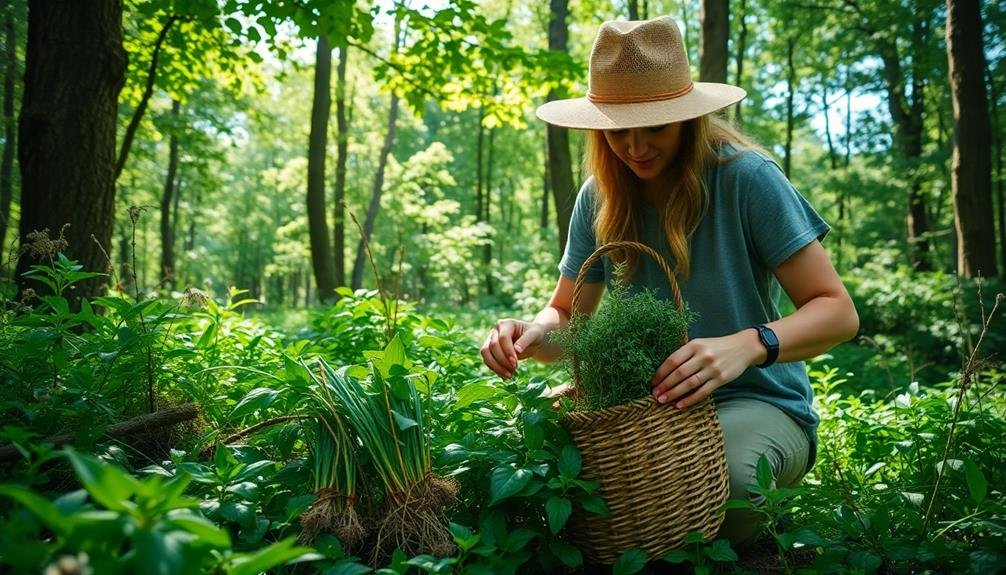
When you're foraging for wild herbs, it's essential to know the local regulations to guarantee you're gathering legally.
Remember to leave no trace by taking only what you need and respecting the environment.
Always harvest in moderation to preserve the plants for future foragers and wildlife.
Know Local Regulations
Foraging for wild herbs can be a rewarding experience, but it's crucial to understand and respect local regulations. Before you set out, check the rules in your area, as they can vary considerably.
Some locations require permits for foraging, while others may have restrictions on certain species due to conservation efforts. Make sure you're familiar with the plants you can harvest and any limitations on quantities.
In some places, you might only be allowed to collect small amounts for personal use. Additionally, certain areas, like national parks or protected lands, often prohibit foraging altogether to preserve native ecosystems.
Don't forget to be aware of seasonal restrictions, as some plants may be off-limits during their flowering or breeding seasons. It's also wise to stay updated on any local environmental initiatives aimed at preserving biodiversity.
Leave No Trace
Responsible foraging means always leaving no trace behind. When you venture out to gather wild herbs, it's crucial to respect the environment and guarantee that your actions don't harm it. Start by only foraging in areas where it's permitted, and avoid disturbing wildlife or natural habitats.
As you collect herbs, be mindful of the plants you choose. Pick only what you need, guaranteeing that you leave enough for the ecosystem to thrive and for others to enjoy. When you move through an area, tread lightly to avoid damaging the surrounding flora.
After foraging, clean up any debris you might've caused. If you bring any packaging or tools, take them back with you. Remember, the beauty of nature is fragile, and your responsible actions help maintain it for future foragers.
Additionally, consider using sustainable practices while foraging. Familiarize yourself with the local flora and learn to identify plants correctly to avoid the risk of picking endangered species.
Harvest in Moderation
Leaving no trace sets the stage for sustainable foraging, and part of that practice is harvesting in moderation. When you venture out to gather wild herbs, it's essential to take only what you need. This approach not only guarantees that plants can regenerate but also maintains the ecosystem's balance.
Aim to harvest no more than 30% of a single plant or patch, allowing the remaining herbs to thrive and reproduce.
Be mindful of the time of year as well. Some herbs may need to mature before you pick them. If you notice a particular species is struggling in your area, consider skipping it altogether for the season. Remember that the most sustainable foragers are those who respect nature's rhythms.
Also, when you're foraging, try to spread your harvesting across different locations. This way, you're not depleting the resources from one area, allowing other foragers and wildlife to benefit as well.
Optimal Foraging Seasons
The best time to forage for wild herbs often depends on the specific plant and its growth cycle. Generally, spring and early summer are prime times for many herbs, as this is when they're actively growing and full of flavor.
You'll find tender young leaves that are perfect for teas during this period. For example, consider foraging for nettles and dandelion greens in late spring, when they're at their peak.
As summer progresses, some herbs like mint and lemon balm thrive, offering vibrant flavors for your teas.
Late summer is also a good time for harvesting seeds and flowers, which can add unique tastes and aromas to your brews.
In fall, you might still find some hardy herbs like sage and thyme, which can withstand cooler temperatures.
However, be mindful of the changing weather, as the first frost can signal the end of the foraging season for many plants.
Harvesting Techniques for Herbs
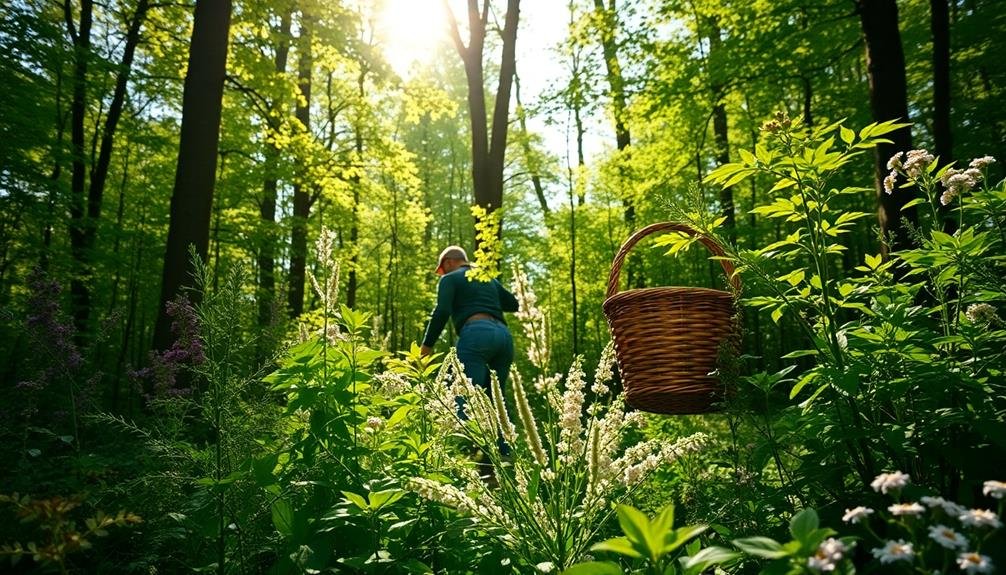
When harvesting herbs, it's essential to use the right techniques to guarantee you get the best flavors while promoting healthy growth.
Start by choosing the right time of day; early morning or late afternoon is ideal when the oils are most concentrated. Always use clean, sharp scissors or pruning shears to avoid damaging the plant.
When you cut, aim for the stems just above a leaf node. This encourages bushier growth and ensures the plant can thrive. Avoid taking more than one-third of the plant at a time, as this can stress it and hinder its recovery.
If you're foraging in the wild, be mindful of the environment. Only harvest from abundant populations and leave enough behind for wildlife and future growth.
Also, make sure you're correctly identifying the herbs to avoid any poisonous look-alikes.
Lastly, remember to wash the herbs gently after harvesting to remove any dirt or insects.
Drying and Storing Methods
After you've harvested your wild herbs, it's crucial to dry and store them properly to preserve their flavors and benefits.
Start by rinsing your herbs gently to remove any dirt or insects. Pat them dry with a clean towel.
Next, you can choose between several drying methods. If you have time, air-drying is a great option. Simply tie small bunches of herbs together and hang them upside down in a well-ventilated, dark area. This method typically takes one to two weeks.
If you're short on time, consider using a dehydrator or your oven on the lowest setting. Spread the herbs in a single layer on a baking sheet and monitor them closely; they should be crumbly but not burnt.
Once dried, store your herbs in airtight containers, like glass jars or vacuum-sealed bags, to keep moisture out. Label them with the name and date of harvest for easy identification later.
Keep your containers in a cool, dark place to maintain their potency. With proper drying and storage, your wild herbs will be ready for delightful teas whenever you crave them!
Creating Herbal Tea Blends

With your wild herbs dried and stored, it's time to get creative and craft your own herbal tea blends.
Start by choosing a base herb that you love, like chamomile for relaxation or mint for a revitalizing taste. Consider the flavors and benefits of the herbs you have. For instance, you might blend lemon balm for a citrusy note with lavender for calming effects.
Experimentation is key. Mix different proportions of herbs until you find the right balance. A good rule of thumb is to start with a 2:1 ratio of your base herb to complementary herbs. You can also add spices like cinnamon or ginger for warmth and depth.
Don't forget about the drying time; the flavors will change as they meld together. Allow your blend to sit for at least a week before tasting.
Once you've perfected your blend, label it with the ingredients and date. This way, you'll remember what you enjoyed and can recreate it later.
Enjoy the process, and don't hesitate to adjust your blends based on seasonal availability or personal preference. Happy brewing!
Frequently Asked Questions
Are There Any Poisonous Plants to Avoid While Foraging?
Yes, there are poisonous plants to avoid while foraging. You should learn to identify plants like belladonna and poison ivy. Always double-check your finds, and when in doubt, don't eat anything you're unsure about.
Can I Forage Herbs in Urban Areas?
Yes, you can forage herbs in urban areas. Just make sure to research local regulations and be aware of pollution. Look for parks or gardens where you can find safe and healthy options to enjoy.
How Can I Ensure My Foraged Herbs Are Pesticide-Free?
To guarantee your foraged herbs are pesticide-free, stick to areas away from roads and agricultural sites. Always ask landowners about pesticide use, and trust your instincts—if something seems off, don't take the herb.
What Tools Are Essential for Successful Herb Foraging?
For successful herb foraging, you'll need sturdy scissors or shears, a well-ventilated basket for collecting, a field guide for identification, and gloves to protect your hands. These tools help guarantee a rewarding and safe foraging experience.
Are There Any Legal Restrictions on Foraging in Certain Areas?
Yes, there're legal restrictions on foraging in many areas. You should check local laws and regulations before you begin. Some parks and private lands prohibit foraging, so always seek permission and understand the rules.
In Summary
By embracing these foraging tips, you'll reveal a world of delicious herbal teas right in your backyard or local park. Remember to respect nature by foraging responsibly and sustainably, ensuring these wild herbs thrive for future generations. Experiment with different blends and enjoy the unique flavors each season brings. So grab your basket, head outdoors, and start crafting your own delightful herbal infusions that not only taste great but also connect you to the natural world.

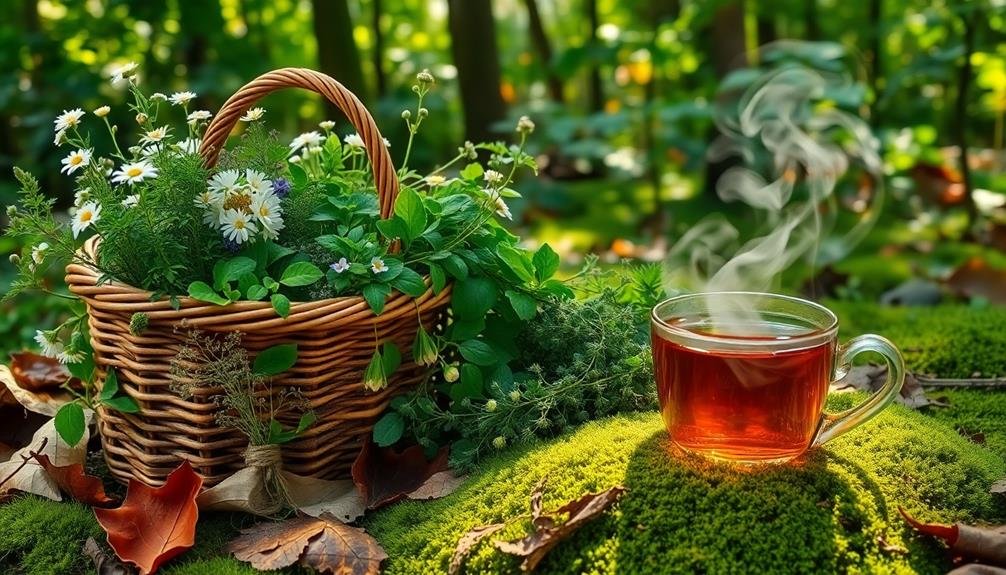
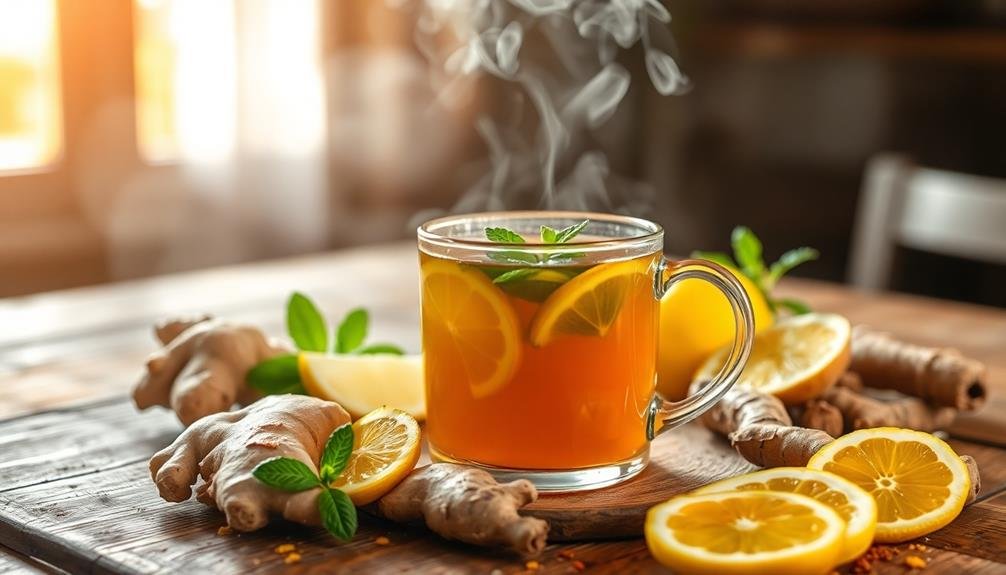
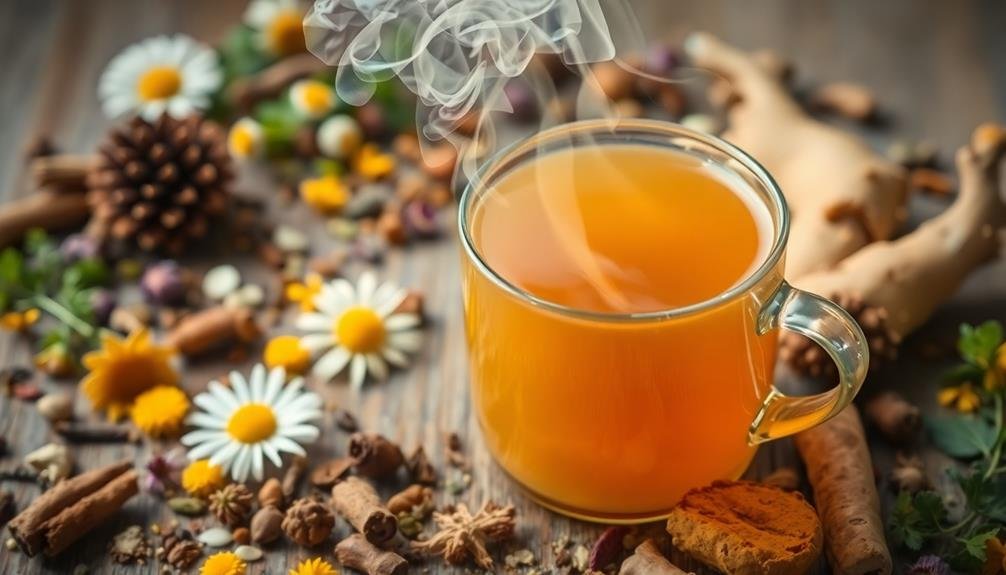
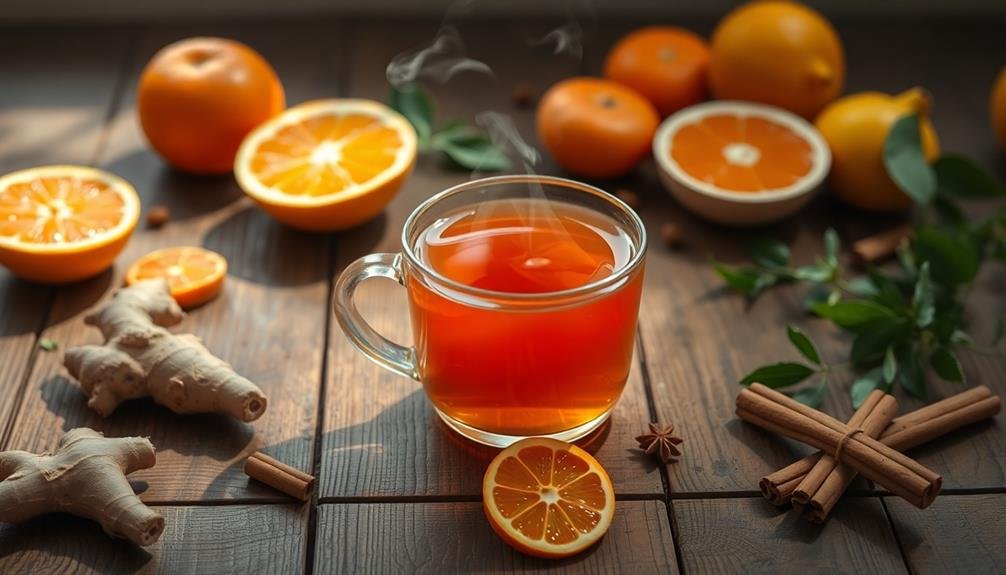
Leave a Reply